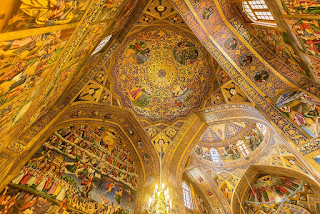Armenian Writers (6th century)
2. Char' yaghags hawatoy (Vagharshapat, 1902).
3. Char' i tsnundn K'ristosi. Recalled by SO, fragments in Mkrtich'ean.
4. T'ught' ar' Yiztibuzt in the journal Ejmiatsin, #1(1966), p. 50.
5. Char' e"ndde'm K'aghkedonakanats'. Recalled by SO.
6. Meknut'iwnk' xrt'in ew dzhuarimats' banits' hin ew nor ktakaranats'. Recalled by SO.
7. Panegyric on Babik Siwnik'. Used by SO.
8. Answers to Vach'agan, Prince of Aghuans, on the Corporealization of the Lord. Ter Mkrtich'ean considers this non-authentic, while Henri Gabrielyan considers it genuine. See Gabrielyan's Patmut'yun hay pilisopayakan patmut'yunits' [History of Armenian Philosophical Thought] (Erevan, 1956), vol. I. pp. 319-321.
N. Akinean has studies of Petros Siwnik' in the journal Hande's Amso'reay 1903, 1904.
—
Bishop Grigor Artsruni, 500?-570?
Grigor Artsruni's name occurs for the first time among the attendees at the Second Council of Dvin in 554. Ten years later he was in Jerusalem, whence he wrote a letter to Armenia about the importance of keeping Tear'ne"ndaraj (Candlemas) on Feb. 14th. In his letter, Grigor describes the disturbances which broke out in Jerusalem during the days of Justinian (527-565) as well as the wonders which appeared to the Orthodox faithful. Grigor's letter was written in 564 and published first in Jerusalem, 1953 and then in 1964 (critical edition). The language is simple, with few hunaban words. Published in Sion.
—
Catholicos Yovhannes II Gabeghean, 510?-574
Yovhanne's II succeeded Nerse's II Bagrewandats'i as Cathoilcos. He was born in Siwndzeghun village, Gabeghean (Kaghzuan), and was earlier a monk at T'at'ul monastery. He became Catholicos in 557 and died in 574, in Constantinople, where he had gone with Vardan Mamikonean to seek aid against the Persians.
Works:
Two of his letters, written around 565, have survived:
1. Ar' Siwneats' Episkoposn (Vrt'anes) ew ar' Te'ar'n (Mihrartashir), in the Book of Letters, pp. 78-80; SO. I. 134-138. About communing with Nestorians in Siwnik'.
2. To the Aghuan Bishops, in BL 81-84, and also Letter from Bishop Giwt [of Armenia] to Saint Vach'e' in History of the Aghuans by Movse's Dasxurants'i, Book I. 11.
Immediately following these letters in BL is a homily entitled The Revelation of Christ by Kat'oghikos Yovhanne's which is considered Gabeghean's work. According to a colophon, E'akats' Girk' was translated from Greek at Yovhanne's II's order in 26 of the Armenian Era (A.D. 577). Durean believes that the colophon relates not to E'akats' Girk' but to the book Sahmanats' Girk' by Dawit'. According to Manandian, under E'akats' Girk' should be understood Aristotle's Storogrut'iwnk'.
—
Bishop Movse's Ts'urtawats'i, 560?-615?
Movse's was born in Mehenkert village, Tashirk' (Lor'i). He received his training at the episcopal school in Ts'urtaw, capital of Gugark', mastering Armenian and Georgian. He became, successively, priest, vardapet, and, in 599, was ordained bishop by the Georgian Catholicos Kiwrion.
Movses was a warm defender of Monophysitism against Nestorianism and Chalcedonianism, watching Kiwrion's attachment to Chalcedonianism with agony. Six of Movses' letters have survived, written in a non-hunaban style, and containing important information on the Armeno-Georgian church split. Three of these are addressed to Vrt'ane's K'ertogh, the kat'oghikosal locum tenens at Dvin.
Works:
1. 605. I. Letter to Vrt'ane's Teghapah, in the Book of Letters, pp. 110-111. The old title bdeshx ("borderlord") appears in this document.
2. 606. Circulating Letter to the Ts'urtaw Church, in BL, pp. 113-118.
3. 606. II. Letter to Vrtane's K'ertogh, in BL. pp. 133-134.
4. 606 III. Letter to Vrtane's Kertogh, in BL, p. 140.
5. 607. Letter to Kat'oghikos Abraham, in BL, pp. 161-162.
6. 608. Letter to Smbat Gurkan (Vrkanits') Marzpan, in BL, pp. 172-173.
—
Vrt'ane's K'ert'ogh, 550?-620?
Vrt'ane's received his education at the episcopal school in Dvin. It is possible that he was ordained dran [court/palace] bishop by Kat'oghikos Movse's Eghivardets'i. During a difficult time (604-607) he served faithfully as locum tenens for the Kat'oghikos (Uxtane's, vol. II. 34, 38). He lived a decade or so after the election of Kat'oghikos Abraham.
Works:
Vrt'ane's K'ert'ogh has left some 10 letters addressed to various individuals about important Church maters. The hunaban school did not leave a strong trace on him, although sometimes his style becomes complicated. Most of his writings have been published, in some cases, in several editions:
1. Yaghags patkeramartits' (c. 600). Published in the journal Sion 1927, pp. 23, 61. An important document on iconodulism within the Church.
2. Letter to Sorme'n Stratelat of Hunahayastan (605-606), in the Book of Letters, pp. 93-98. According to Durean, this belongs to Vardapet Prince, son of K'ch'kan. In Sion 1928, pp. 305-312.
3-5. Letters to Bishop Movse's Ts'urtawats'i (605-606). I. BL, p. 112, Uxtane's vol. II. pp. 26-27; II. BL, p. 135, Uxtane's II. p. 41; III. BL, pp. 141-145, Uxtane's II. pp. 49-53.
6. Circulating Letter to the Church at Ts'urtaw (606). In BL, pp. 130-131, Uxtane's II. p. 32.
7. Letter to Petros the Georgian (606). In BL, pp. 136-137, Uxtane's II. p. 44.
8. Letter to the Georgian Kat'oghikos Kiwrion (606). In BL, pp. 138-139, Uxtane's II. pp. 43-44.
9. Letter to Bishop Mxit'ar of Amaras (608-609). In BL, pp. 196-211, defective; Ararat, 1896 pp. 477-488.
10. Brief History of the Construction of the Shrine of the Hr'ip'simeans by Kat'oghikos Kumitas (618-619). This is referred to in the Matenagrats' Ts'uts'ak of Haykazean Lezui Nor Bar'girk' (Vol. I. p. 19), but has not been discovered since.
11. Patchark' ch'ors zhoghovoyn erkabnakats'n (606). In BL, pp. 119-127. On this, see N. Akinean Hande's Amso'reay 1910, pp. 39-45.
12. Yaghags e"nddimamartits' kensaber lusoyn. This is an Ejmiatsin manuscript, referred to in Ararat, 1902, p. 565.
—


Comments
Post a Comment